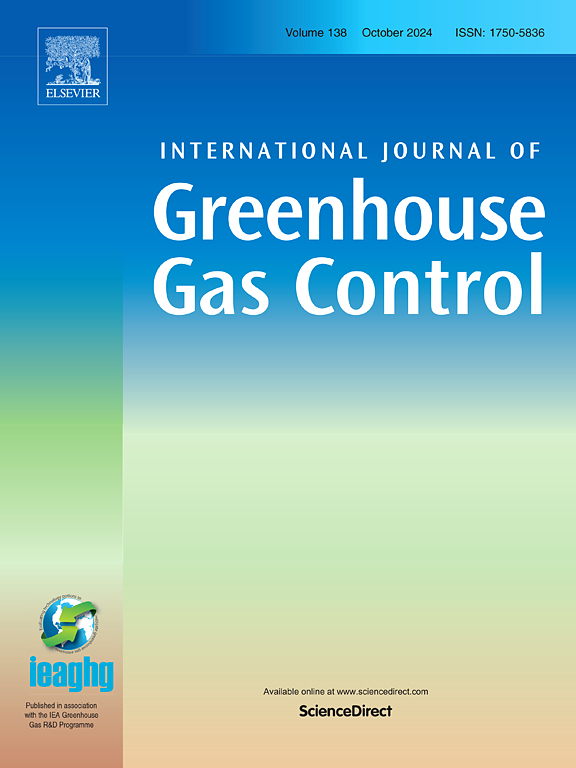纽芬兰Baie Verte地区蛇纹石化超镁质岩的CO2封存潜力评估
IF 5.2
3区 工程技术
Q2 ENERGY & FUELS
International Journal of Greenhouse Gas Control
Pub Date : 2025-08-04
DOI:10.1016/j.ijggc.2025.104444
引用次数: 0
摘要
摘要本研究探讨了产自美国贝维特的蛇纹石对二氧化碳的固存潜力。采用两种实验方法对Baie Verte海洋带蛇纹岩化超镁铁岩进行了测试:两相渗流系统,模拟富蛇纹岩体系中近地表水-岩反应的矿物溶解;以及模拟表面二氧化碳去除(CDR)的三相间歇系统。在这两个实验中,流体通过破碎的蛇纹石的溶解迅速缓冲到碱性pH值~ 10。pH值的变化创造了有利于CO2溶解的系统。表面CDR实验观察到CO2从气相固存到固相,流体相CO2减少,总无机碳(TIC)增加。在富mgoh流体的CDR实验中,从腔室中去除的CO2总量大约等于流体中获得的TIC量。相反,在岩石实验中,流体相中获得的TIC大约是气相中CO2去除量的5倍。正如地球化学模型预测的那样,过量的TIC可能来自方解石的溶解。在我们的实验中,除了可能析出的白云石和菱镁矿外,封存的二氧化碳都保持在溶解相中。有趣的是,方解石的溶解并不影响封存的二氧化碳总量或白云石或菱镁矿的沉淀潜力。因此,当外推到现场时,二氧化碳封存仍然可以发生在缓冲系统中,其中碳酸盐岩会随着水的加入而溶解。本文章由计算机程序翻译,如有差异,请以英文原文为准。
Assessing the CO2 sequestration potential of serpentinized ultramafic rocks in Baie Verte, Newfoundland
This study investigated the CO2 sequestration potential of serpentine from Baie Verte, NL. Serpentinized ultramafic rocks of the Baie Verte Oceanic Tract were tested using two experimental approaches: a two-phase flow-through system, simulating mineral dissolution of near-surface water-rock reactions in serpentinite-rich systems; and a three-phase batch system, simulating surficial carbon dioxide removal (CDR). In both experiments, the fluids were rapidly buffered to basic pH values of ∼10 through the dissolution of crushed serpentine rock. The change in the pH created systems favourable for CO2 dissolution. CO2 sequestration from the gaseous-phase to the dissolved-phase was observed in the surficial CDR experiments, with a decrease in CO2 and an increase in total inorganic carbon (TIC) in the fluid phase. The total CO2 removed from the chamber of the CDR experiments with MgOH-rich fluids approximately equalled the amount of TIC gained in the fluid. Conversely, in experiments with rocks, the TIC gained in the fluid-phase was approximately five times the amount of CO2 removed from the gas-phase. The excess TIC likely came from the dissolution of calcite, as predicted by geochemical modelling. With the exception of potentially precipitating dolomite and magnesite, the sequestered CO2 in our experiments remained in the dissolved-phase. Interestingly, calcite dissolution did not affect the total amount of CO2 sequestrated or the potential for dolomite or magnesite to precipitate. Therefore, when extrapolating to the field, CO2 sequestration can still occur in a buffered system where carbonate rocks will dissolve with the addition of water.
求助全文
通过发布文献求助,成功后即可免费获取论文全文。
去求助
来源期刊
CiteScore
9.20
自引率
10.30%
发文量
199
审稿时长
4.8 months
期刊介绍:
The International Journal of Greenhouse Gas Control is a peer reviewed journal focusing on scientific and engineering developments in greenhouse gas control through capture and storage at large stationary emitters in the power sector and in other major resource, manufacturing and production industries. The Journal covers all greenhouse gas emissions within the power and industrial sectors, and comprises both technical and non-technical related literature in one volume. Original research, review and comments papers are included.

 求助内容:
求助内容: 应助结果提醒方式:
应助结果提醒方式:


